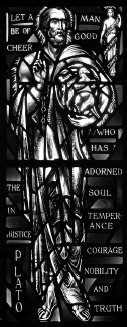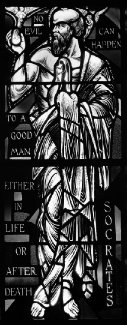Dismantling Connick Windows
Paul F. Norton
|
The realization that several stained glass
windows by Charles Connick are no longer in the buildings for which they were
designed is very disturbing. Unlike oil paintings and prints, that only require
front lighting, stained glass windows must have exterior
light. Furthermore, the choice of glass for best effect depends upon the
direction and intensity of the exterior light source and
the distance from which the glass is viewed. Given these limitations it is
easily understood that moving windows from one place to another
produces serious lighting problems. Unfortunately, there
is today a tendency to underestimate the inherent value of windows designed by
major stained glass artists.
Two Connick windows (see photographs on the
overleaf) disappeared from Dwight Hall, Mount Holyoke College in 1970.
After long faculty discussions over the subjects, cost and position in Dwight,
then serving as the Art building, the windows were
commissioned and installed in 1940. They occupied the double window above the
door facing the west toward College Street. Choices of
subjects were "St. George Killing the Dragon" and "St.
Francis." Beneath these are figures of Princess Una
from The Faerie Queen and St. Clair. The windows were highly admired by all who
saw them. After erection of the new Art Building, Dwight became
mainly office space, including the area just inside the
Connick stained glass. The dark windows did not allow enough light, so they were
removed and crated. No plan exists to reinstall them.
|

Central
portion of window
symbolizing Plato,
University of Kansas. Plato
holds the symbol of restive
and rebellious spirits, the
horses of the soul.
|
At the University of Kansas, two Connick
windows were installed in the Spooner-Thayer Art Museum
in 1937. The themes chosen were "Plato" and
"Socrates." Soon the windows became so popular
that literally thousands of museum visitors saw and
appreciated them. However, the Museum of Anthropology
took over Spooner Hall in 1978 and removed the windows.
When the University built their new Thayer Art Museum in
the 1970's, no plan was made for reinstalling the windows.
Instead they went into storage for the next twenty-five years.
Has any damage occurred owing to the removal of
these windows from public view? To give an answer one
must believe that Connick windows possess qualities of
beauty rarely matched by other American stained glass
artists. Not only are they very beautiful, but they have
depth of meaning derived from Connick's broad
acquaintance with literature, history and the arts. He said about
a window at Mt. Holyoke: "You will probably notice first the
little figure of Princess Una saved from the Dragon, according
to Spenser; Sister Clare, the lily, the rose, the trumpeting
boy and the singing girl, the two fragments of rainbows suggesting the beauty of great lives, Sister Moon for
romance, and Brother Sun for the loveliness of
the workaday world."
At both institutions the students and
the visiting public have for many
years been unable to benefit from seeing windows of such exceptional
quality. Each one is designed with richly colored glass
appropriate to the lighting conditions and the stories they tell.
Is the cost of installation so great that important institutions of
higher learning cannot muster the necessary funds? Rare opportunities to
enrich lives should not be lost.
|

Central
portion of Socrates window
at the University of
Kansas. Socrates
holds aloft in his right
hand the Greek figure of
victory and in his left
hand the Greek symbol of
death. |
|
When
a modern Titan of the arts creates windows of such beauty, it is negligent to
keep them hidden from public view.
A
happy circumstance, recently reported by Professor DeGeorge of the University of
Kansas, is that their Connick windows
will be reinstalled in the Humanities Building during the Spring of 2003.
Paul
F. Norton is retired Professor of the History of Art & Architecture at the
University of Massachusetts at Amherst. He is
now
concentrating on discovering and researching the history of stained glass
windows and has recently published the book:
"Rhode
Island Stained Glass, an Historical Guide." A recent article in the April
2003 issue of the journal "Nineteenth Century"
(a
publication of the Victorian Society) is entitled "The Gorham Manufacturing
Company and its American Window
Department."
Dr. Norton gave the Orin E. Skinner Annual Lecture on Stained Glass in 1998.
|
|
Reverend
Robert Windsor, because of new church responsibilities, resigned as
director. We shall miss his helpful insights
and general caring for the Connick ideals of stained glass.
Janice Chadbourne, Curator of the Connick Archive,
Fine Arts Department, Boston Public Library, reported that 17,007 Connick
items were consulted from March
2002 to February 2003.
Photographs
in this Newsletter are courtesy of the Trustees of the Boston Public
Library.
|
|
|
"ON
A HOT JULY DAY in nineteen hundred and three, a group of about twenty-six men
met at the Southern Hotel in Columbus,
Ohio to organize the National Ornamental Glass Manufacturers'
Association." (Orin E. Skinner, Stained Glass Quarterly
summer 1978) This organization of stained glass workers became the Stained
Glass Association of American, and as
such, the organization will celebrate their one-hundredth anniversary June
17th to June 22nd once again in Columbus,
Ohio. The Stained Glass Association, established as a trade organization for
the stained glass industry, seeks 'to maintain
the highest possible standards for excellence in craftsmanship, integrity and
business practices'.
E.
Crosby Willet of the Willet Stained Glass Studios, Philadelphia, will present
a major address at the conference on American
Stained Glass Studios of the Twentieth Century. This slide lecture will in
part be dedicated to the work of the Charles
J. Connick Studio. More information about the summer conference is available
from the Stained Glass Association,
telephone (800) 438-9581.
An
abbreviated list of Connick installations in Ohio is as follows: Kenyon
College in Gambier, where there is an entire glazing
scheme (located in Peirce Hall) of English speaking literary themes from
Beowulf to our twentieth-century American
authors (see June 1996 Connick Windows); Childrens' Hospital, Cincinnati (see
February 1998 Connick Windows); First
Congregational Church, Columbus; Christ Church, Glendale; Saint James,
Zanesville.
|
| The
Connick Foundation wishes all of you a summer filled with light. |
 |
Connick Windows
"I want to make beautiful interiors for both churches
and souls
I want...[all people] to hear my windows singing..."
Charles J. Connick
Windows symbolizing Saint George (left) and Saint Francis
(right) originally installed in
the Arts Building of Mount Holyoke College, South Hadley, Massachusetts |
 |
|

